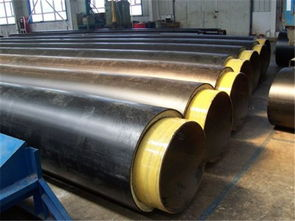保温管集中供热系统中热力失调问题就要详细问题详细剖析。普通状况下,关于温度失调,经过检查肯定缘由之后,能够选择优化热源设备,保证热源供热充足,或者改换用户换热器,提升换热器的换热效率,都能够很好地处理温度失调的问题。
Thermodynamic imbalance in heat-insulating pipe central heating system should be analyzed in detail. Under normal conditions, the problem of temperature imbalance can be well handled by choosing optimal heat source equipment, ensuring adequate heat supply, or changing user heat exchangers to improve the heat exchange efficiency of heat exchangers after checking and confirming the reasons.
保温管集中供热系统的水力失调问题的处理方法愈加普遍、多样,详细包括:
Hydraulic imbalance of heat preservation pipe central heating system is becoming more and more common and diverse, including:
节阀的运用。运用调理阀是缓解集中供热系统热力失调,保证水力均衡的一个重要措施。保温管网中运用的调理阀主要有静态调理阀、动态流量均衡阀和动态压差均衡阀三种主要类型。
Application of throttle valve. The use of conditioning valve is an important measure to alleviate the thermal imbalance of central heating system and ensure the hydraulic balance. There are three main types of regulating valves used in heat preservation pipeline network: static regulating valves, dynamic flow equalizing valves and dynamic differential pressure equalizing valves.
详细来说,静态调理阀在水力均衡中起着根底性的调理作用,其工作原理是经过对管道内阻力的调理,到达对孔板调理的目的,进而均衡保温管管网中的阻力,因而,静态调理阀是人工调理操作的。
In detail, the static conditioning valve plays a fundamental role in hydraulic balancing. Its working principle is to adjust the resistance in the pipeline to reach the purpose of orifice plate conditioning, and then balance the resistance in the insulation pipe network. Therefore, the static conditioning valve is an artificial conditioning operation.
动态流量均衡阀也叫自力式流量控制阀,是完成管网的水力均衡的重要设备。详细的工作原理是,依据阀门的前后压的不同,对阀门停止自动开大或开小,保证对流量的恒定,到达对流量的合理控制。恒流量调理阀是一种新型的动态流量调控设备,能够完成各環路流量的自主调理,保证热力管网的水力均衡。相比于原有的调理阀需求人力操作,恒流量调理阀的一切系列都可以装置电动执行器,并且衔接到热力管网的自动控制系统中,完成供热系统的自动化控制。相较于原来的人力调理阀,恒流量调理阀的操作愈加便当快捷、简单智能,并且装置本钱并不高.

Dynamic flow equalization valve, also known as self-operated flow control valve, is an important equipment to complete the hydraulic equalization of the pipeline network. Detailed working principle is that according to the different pressures of the front and back of the valve, the valve stops automatically opening large or small to ensure that the flow is constant and the flow is controlled reasonably. Constant flow conditioning valve is a new type of dynamic flow control equipment, which can complete the flow self-regulation of each loop and ensure the hydraulic balance of the thermal pipe network. Compared with the original conditioning valves, all series of constant flow conditioning valves can be equipped with electric actuators, and connected to the automatic control system of the heating network to complete the automatic control of the heating system. Compared with the original manual control valve, the constant flow control valve is more convenient, simple and intelligent, and the cost of the device is not high.
态压差均衡阀,也叫作自力式均衡阀,是一种经过对压差的丈量和调试,为热力管网调理提供数据参考的系统,详细的工作原理是,当保温管道内流量产生变化时,自力阀的阀芯会随之上下挪动,这样一来,自力阀的流量面积和流量系数会变得不同,但是在不同位置上也会一直保证阀芯和阀座完成均衡,保证差压值坚持不变。通常状况下,动态压差均衡阀要在每一个控制节点都停止装置,从而完成关于热力管网的整体监测。
State pressure differential equalization valve, also known as self-balancing valve, is a kind of system which provides data reference for the regulation of thermal pipe network after measuring and debugging the pressure difference. The detailed working principle is that when the flow in the insulation pipe changes, the valve core of the self-balancing valve will move up and down accordingly. Thus, the flow area of the self-balancing valve will be moved up and down. Flow coefficient and flow coefficient will become different, but in different locations will always ensure that the spool and seat are balanced, to ensure that the differential pressure value remains unchanged. Usually, the dynamic differential pressure equalization valve should stop the device at each control node to complete the overall monitoring of the thermal network.
②加压泵的运用。运用加压泵主要是指在供热不利端装置加压泵加压泵的运用是处理热力管网水利失调,保证水力均衡的又一重要措施。这是由于供热系统循环水泵实践扬程和流量并不是固定不变且一直坚持充足的状态,因而在实践运转中,就会呈现保温管热网中循环水泵实践扬程和流量不够的状况,这就势必会形成远处供热不利端的资用压头或流量缺乏。所以,在供热不利端用户的换热站内加装水泵,就有助于保证不利端用户供热流量.
(2) Application of pressure pump. The use of pressurized pumps mainly refers to the use of pressurized pumps at the disadvantageous end of heating, which is another important measure to deal with the hydraulic imbalance of the thermal pipe network and ensure the hydraulic balance. This is because the practice head and flow of circulating water pump in heating system are not fixed and have been adhering to sufficient conditions, so in practice, there will be insufficient practice head and flow of circulating water pump in heat insulation pipe network, which will inevitably lead to the lack of capital pressure head or flow at the disadvantageous end of distant heating. Therefore, installing water pumps in heat exchanger stations of unfavorable end users will help to ensure the heating flow of unfavorable end users.
留意的是,在换热站内加装水泵,必需要慎重选择、合理装置,防止影响周边其他用户的流量,形成更严重的水力失调,如“抢水”问题等。选择水泵,一方面要理解换热站内已知的参数,另一方面要理解所需的详细资用压头和流量,二者分离作为选择水泵的参考规范。通常状况下小型加压水泵已足够满足大多数用户的需求。目前水泵的类型丰厚多样、技术成熟,有小流量、小扬程、低噪音、免维护水泵,还有技术含量更高的三挡变速水泵、带变频的可自动调理(流量、温度、压力、压差)的无级变速水泵。
Attention should be paid to installing water pumps in heat exchanger stations, which should be carefully selected and reasonably installed to prevent the flow rate affecting other users around them from forming more serious hydraulic imbalances, such as "water grabbing" problems. To select pumps, one needs to understand the known parameters in the heat exchanger station, and the other needs to understand the detailed information of pressure head and flow. Separation of the two is used as a reference criterion for selecting pumps. Usually, small pressurized pumps are enough to meet the needs of most users. At present, the types of pumps are rich and varied, and the technology is mature. There are small flow, small lift, low noise, maintenance-free pumps, and three-speed variable-speed pumps with higher technical content, and continuously variable-speed pumps with frequency conversion (flow, temperature, pressure, differential pressure).
③供热系统设备的优化。供热系统设备的优化,主要是关于老化、不合格、不合理管道,供热效率低的锅炉和热能转化率低的换热器等设备停止优化改造,进步保温管集中供热系统的热量,减少热量保送中的丧失和损耗,进步二次热能的转化率,减少热力失调现象的呈现。综上所述,形成保温管中供热系统热力失调主要有温度失调和水力失调两种状况,针对这两种实践状况的不同,选择和采用不同的有针对性的处理办法,能够大大处理热力失调问题,保证集中供热系统的平稳运转、均衡分配,促进集中供热系统晋级。
(3) The optimization of heating system equipment. The optimization of heating system equipment is mainly concerned with aging, unqualified and unreasonable pipes, boilers with low heating efficiency and heat exchangers with low heat energy conversion rate, etc. to stop the optimization and transformation, to improve the heat of heat preservation pipe central heating system, to reduce the loss and loss in heat storage, to improve the conversion rate of secondary heat energy and to reduce it. Presentation of thermodynamic imbalance. To sum up, there are mainly two kinds of thermal imbalance in heat-supply system of insulation pipe: temperature imbalance and hydraulic imbalance. In view of the difference between the two practical conditions, different targeted treatment methods are selected and adopted, which can greatly deal with the thermal imbalance problem and ensure the smooth operation and balanced distribution of central heating system. Promote the promotion of central heating system.







